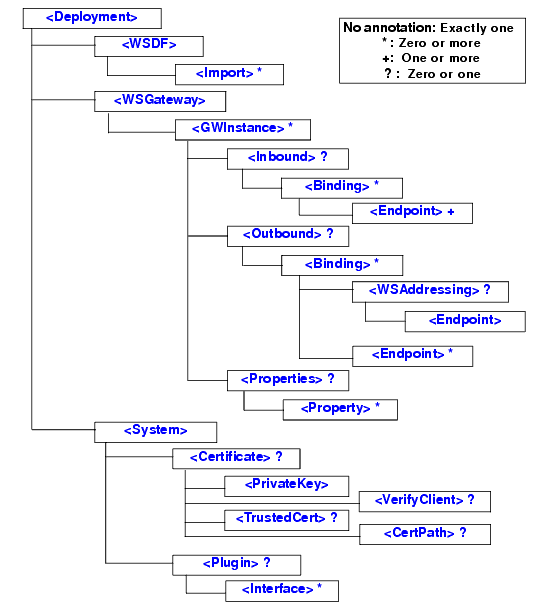







|
The following sections provide SALT Deployment File reference information
The Oracle SALT Deployment File (SALTDEPLOY) is an XML-based file used to define Oracle SALT GWWS server deployment information on a per Tuxedo machine basis. SALTDEPLOY does the following:
SALTDEPLOY also provides a system section to configure global resources (for example certificates, plug-in load libraries, and so on).
Figure B-1 shows a graphical representation of the Oracle SALT SALTDEPLOY format.

An XML Schema is associated with an Oracle SALT Deployment File. The XML Schema file that describes the Oracle SALT Deployment File format is located in the following directory: $TUXDIR/udataobj/salt/saltdep.xsd.
Listing B-1 shows a sample SALT Deployment File.
<Deployment xmlns=”http://www.bea.com/Tuxedo/SALTDEPLOY/2007”>
<WSDF>
<Import location="/home/myapp/bankapp.wsdf" />
<Import location="/home/myapp/amazon.wsdf" />
</WSDF>
<WSGateway>
<GWInstance id="GW1">
<Inbound>
<Binding ref="bankapp:bankapp_binding">
<Endpoint use="http1"/>
<Endpoint use="https1" />
</Binding>
</Inbound>
<Outbound>
<Binding ref="amazon:default_binding"/>
</Outbound>
</GWInstance>
</WSGateway>
<System>
<Certificate>
<PrivateKey>/home/user/cert.pem</PrivateKey>
</Certificate>
<Plugin>
<Interface library=”/home/user/mydatahandler.so” />
</Plugin>
</System>
</Deployment>
SALTDEPLOYF format elements and their attributes are listed and described in the following section.
The SALTDEPLOY file root element.
There is no attribute for this element.
Three sections must be defined within the <Deployment> element:
<WSDF> elements<WSGateway> element <System> element.
There can be only one <Deployment> element defined in a SALTDEPLOY file.
Top element that encapsulates all imported WSDF files.
There is no attribute for this element.
Specifies the WSDF to be imported in the SALTDEPLOY file. Multiple WSDF can be imported at the same time. Each WSDF file can only be imported once. Multiple WSDF with the same WSDF name cannot be imported in the same SALTDEPLOY file. Table B-1 lists the <Import> attributes.
Top element that encapsulates all GWWS instance definitions.
There are no attributes for this element.
Specifies a single GWWS instance. Table B-2 lists the <GWinstance> attributes.
Specifies inbound WSBinding objects for the GWWS server. Each inbound WSBinding object is specified using the <Binding> sub element.
There is no attribute for this element.
Specifies outbound WSBinding objects for the GWWS server. Each outbound WSBinding object is specified using the <Binding> sub element.
There are no attributes for this element.
Specifies a concrete WSBinding object as either an inbound or outbound binding, depending on the parent element. Table B-3 lists the <Binding> attributes.
| Note: | Please note the following maximum WSBinding object limitations for each GWWS server: |
For TCP/IP addresses, one of the following formats is used as shown in Table B-4.
For more information, see TMUSEIPV6 in the TUXENV(5) environment variable listing found in the Tuxedo 10g R3 Reference Guide, Section 5 - File Formats, Data Descriptions, MIBs, and System Processes Reference.
Specifies a single WSBinding objects endpoint reference.
If the referenced endpoint is specified as an inbound endpoint, the GWWS server creates the corresponding HTTP and/or HTTPS listen endpoint. At least one inbound endpoint must be specified for one inbound WSBinding object.
If the referenced endpoint is specified as an outbound endpoint, the GWWS server creates HTTP and/or HTTPS connections per SOAP requests for the outbound WSBinding object.
If an outbound endpoint is not specified for the outbound WSBinding object, the first 10 endpoints (at most) are auto-selected.
The referenced endpoint must already be defined in the WSDF.Table B-5 lists the <Endpoint> attributes.
| Note: | Please note the following maximum endpoints limitations for each GWWS server: |
Specifies if Web Service Addressing is enabled for the outbound WSBinding object.
If this element is present, by default all SOAP messages are sent out with a Web Service Addressing message header. The sub element <Endpoint> must be specified for the listen endpoint address if this element is present.
There is no attribute for this element.
Specifies the WS-Addressing listen endpoint address for the referenced outbound WSBinding object. Table B-6 lists the <Endpoint> attributes.
Top element that encapsulates all GWWS server property settings using the <Property> sub element.
There are no attributes for this element.
Specifies a single GWWS property. Table B-7 lists the <Property> attributes. Table B-8 shows the <Property> listings.
Specifies the property name. Table B-8 lists all the GWWS server properties.
|
||
Specifies global settings, including certificate information, plug-in interfaces.
Specifies global certificate information using sub elements <PrivateKey>, <VerifyClient>, <TrustedCert> and <CertPath>.
There are no attributes for this element.
Specifies the PEM format private key file. The key file path is specified as the text value for this element. The server certificate is also stored in this private key file. The value of this element may contain a maximum of 256 characters (excluding the terminating NULL character).
This element is mandatory if the parent <Certificate> element is configured.
Specifies if Web service clients are required to send a certificate via HTTP over SSL connections. The valid element values are "true" and "false".
This element is optional. If not specified, the default value is "false".
Specifies the file name of the trusted PEM format certificate files. The value of this element may contain a maximum of 256 characters (excluding the terminating NULL character).
Specifies the local directory where the trusted certificates are located. The value of this element may contain a maximum of 256 characters (excluding the terminating NULL character).
| Note: | If <VerifyClient> is set to “true”, or if WS-Addressing is used with SSL, trusted certificates must be stored in the directory setting with this element. |
Specifies the global plug-in load library information. Each <Interface> sub element specifies one plug-in library to be loaded.
There is no attribute for this element.
Specifies one particular plug-in interface or a plug-in library for all plug-in interfaces inside the library. Table B-9 lists the <Intereface> attributes.
| Note: | For more information about how to develop a SALT plug-in interface, see “ Using Oracle SALT Plug-ins” in the Oracle SALT Programming Web Services. |


|